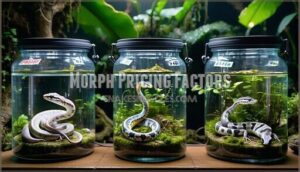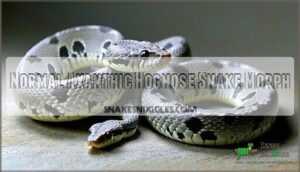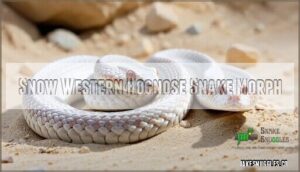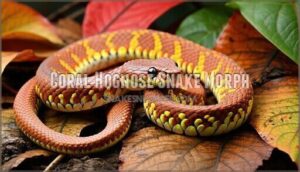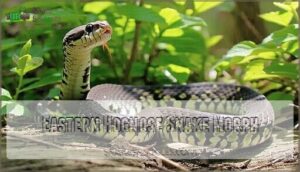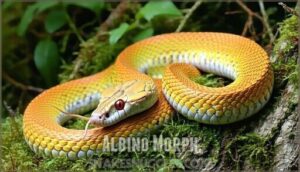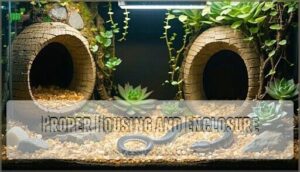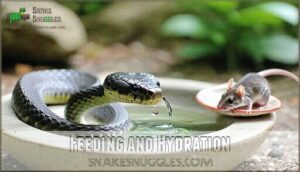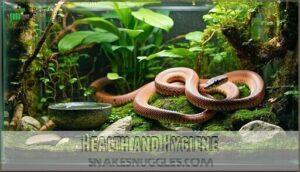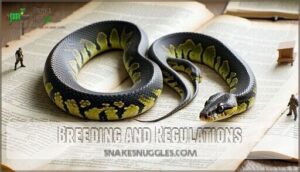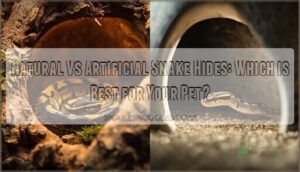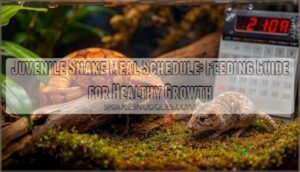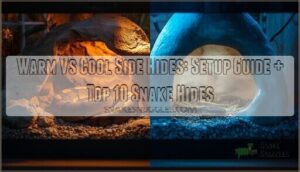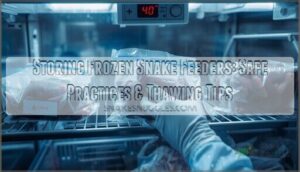This site is supported by our readers. We may earn a commission, at no cost to you, if you purchase through links.
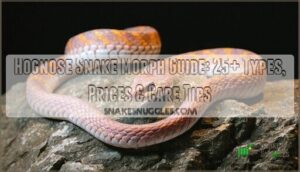 You’ll find hognose snake morphs ranging from basic normals at $50-100 to stunning rarities like coral snow morphs hitting $1,000+.
You’ll find hognose snake morphs ranging from basic normals at $50-100 to stunning rarities like coral snow morphs hitting $1,000+.
This hognose snake morph guide covers genetics, pricing factors, and care essentials for western hognose varieties.
Popular morphs include albinos, snows, axanthics, and corals—each displaying unique color patterns through selective breeding.
Morph prices depend on rarity, genetics, age, and breeder reputation.
Western hognose snakes make excellent pets due to their docile nature and compact size.
Whether you’re eyeing your first morph or planning breeding projects, understanding genetic inheritance and market trends helps you make smart choices that won’t break the bank.
Table Of Contents
- Key Takeaways
- Hognose Snake Morphs
- Morph Pricing Factors
- Cool Hognose Snake Morphs
- Caring for Hognose Snakes
- Breeding and Regulations
- Frequently Asked Questions (FAQs)
- What is the rarest morph of a hognose snake?
- What is the most docile hognose snake?
- What is a ghost hognose snake?
- Are hognose snake morphs safe to keep with children?
- Do morphs affect a hognose snake’s temperament?
- Can hognose morphs be housed together safely?
- How to identify a genuine hognose morph?
- Are there health risks unique to certain morphs?
- Conclusion
Key Takeaways
- You’ll pay dramatically different prices – common morphs, like normals, cost $50-100, while rare combinations, like coral snows, can hit $1,000+ depending on genetics and rarity
- Females cost more because they’re breeding goldmines – expect to pay $50-200 extra for females, since they produce offspring, making them valuable investments for serious breeders
- All morphs need identical care, regardless of their stunning colors – housing, feeding, and handling requirements stay the same, whether you’ve got a basic normal or an expensive designer morph
- You’ll need proper permits and research before breeding – over 30 states require licenses, costing $10-125, and some states, like Illinois, protect certain hognose species as threatened
Hognose Snake Morphs
You’ll discover that hognose snake morphs are genetic variations that create stunning color and pattern differences within the same species.
These unique traits come from selective breeding, turning ordinary snakes into living works of art that can cost anywhere from $60 to thousands of dollars, making them living works of art.
What is a Hognose Snake Morph
A hognose snake morph represents unique color or pattern variations created through genetic mutations.
These visual traits result from selective breeding and trait inheritance, showcasing nature’s diversity within a single species.
Think of morphs as different "flavors" of the same snake—each with distinct appearances that make collectors go wild for these fascinating reptiles, and it is the unique color or pattern variations that make them so diverse.
Each hognose morph is nature’s masterpiece with its own personality and price tag.
How Many Species of Hognose Snakes Are There
Snake diversity reaches fascinating heights with hognose species.
You’ll find up to five distinct species across North and South America, each with unique characteristics that make identification straightforward once you know what to look for.
They’re known for their upturned snout, which aids in digging.
- Eastern hognose snake (Heterodon platirhinos) – widespread North American species with G5 conservation status
- Western hognose snake (Heterodon nasicus) – endemic to North America, popular in the pet trade
- Southern hognose snake (Heterodon simus) – smaller range, more specialized habitat requirements
- South American hognose snake (Lystrophis dorbignyi) – geographically separate from North American relatives
- Jan’s hognose snake (Lystrophis histricus) – another South American species with distinct morphological features
Genetic Variation and Trait Inheritance
You’re looking at genetic lottery tickets when breeding hognose snakes.
Morph heritability follows predictable patterns through recessive genes, co-dominance, and polygenic traits.
Selective breeding combines these genetic variations strategically – like mixing paint colors to create new shades.
Snake genetics work through trait inheritance where some features need two copies to appear, while others show up with just one.
Understanding reptile genetics helps predict offspring outcomes.
Morph Pricing Factors
When you’re shopping for a hognose snake morph, you’ll quickly discover that prices can range from around $60 for common varieties to several thousand dollars for rare specimens.
Several key factors determine these dramatic price differences, including the morph’s rarity, the snake’s age and sex, and the quality of its genetic lineage, which are crucial in understanding why some snakes are more expensive than others, with rarity being a significant factor.
Morph Rarity and Price
When you’re eyeing hognose morphs, rarity and price go hand in hand.
Wild-types are budget-friendly, but rare morphs like Leucistic or Swiss Chocolate can cost as much as a used car.
Morph demand trends, investment potential morphs, and morph availability all shape morph pricing.
Hognose snakes are popular pets, with Western hognoses preferred due to their docile nature.
Ethical pricing concerns and morph market stability keep future morph prices unpredictable.
Age and Size Impact
Surprisingly, age and size variations substantially affect hognose morph pricing, with younger snakes offering better value for patient collectors.
Hatchling prices start lower but require more Hatchling Care, while Adult Size specimens command premium costs due to proven Growth Rate and established genetics.
- Hatchling prices typically run 30-50% less than adults of identical morphs
- Juvenile costs increase as snakes approach Breeding Age around 18-24 months
- Adult value peaks when breeders reach proven reproductive status
- Size Genetics become apparent as snakes mature, affecting final pricing
- Growth Rate variations can impact long-term investment potential for serious collectors
Sex and Pricing
You’ll pay more for female hognose morphs due to their breeding potential. Females typically cost $50-$200 extra since they’re the gender investment that produces offspring.
Female hognose morphs command premium prices—they’re the breeding goldmine every collector wants.
While sexing methods can be tricky with young snakes, maturity pricing reflects this value difference. Gender ratios in the market favor females for serious breeders.
| Factor | Male Pricing | Female Pricing |
|---|---|---|
| Common Morphs | $60-$80 | $110-$280 |
| Rare Morphs | $300-$500 | $400-$700 |
| Proven Breeders | $200-$400 | $500-$1,000 |
| Young Adults | $100-$200 | $200-$400 |
| Market Demand | Lower | Higher |
The pricing difference is largely due to the market demand, which is higher for females, and the fact that females are the ones that produce offspring. This makes them a valuable investment for serious breeders.
Genetics and Bloodlines
Three key factors determine a hognose’s value beyond its looks.
Documented lineage tracking proves genetic mutations and trait expression patterns, making bloodlines worth hundreds more.
Snake genetics involving selective breeding creates reliable morph combinations – you’re buying predictable offspring potential.
Genetic diversity prevents inbreeding issues, so established breeders with varied genetic inheritance command premium prices for healthier stock because they offer genetic diversity.
Cool Hognose Snake Morphs
You’ll find some truly stunning variations when exploring different hognose snake morphs, from the striking grayscale beauty of axanthic morphs to the snow-white elegance of rare combinations.
These genetic variations showcase nature’s artistry through selective breeding, offering everything from budget-friendly options to collector-worthy specimens that command premium prices, highlighting the striking beauty of these unique creatures.
Normal Axanthic Hognose Snake Morph
If you’re drawn to grayscale genetics, the Normal Axanthic hognose morph is a showstopper.
This snake morph ditches yellow, rocking shades of white, gray, and black—thanks to melanism absence.
When breeding axanthics, you’ll notice:
- Dark spot variations on each snake
- Reliable inheritance of color traits
- Unique look among hognose morphs
- Straightforward Axanthic health requirements
These morphs exhibit a striking black pattern, which is a key aspect of their unique look.
Snow Western Hognose Snake Morph
The Snow Western hognose morph is a showstopper in any hognose morph guide.
Thanks to Snow genetics—combining albino and axanthic traits—you get a nearly white snake with faint pink undertones and red eyes.
Its visual characteristics are stunning, and its breeding potential is high. With proper husbandry specifics, these snake morphs can fetch top market value among hognose enthusiasts.
Coral Hognose Snake Morph
Anyone who’s fallen for those striking pink hues knows the coral hognose snake morph packs serious visual punch.
This double recessive beauty combines Lavender and Albino genetics, creating breathtaking color intensity with salmon-pink bodies and vibrant red eyes.
Pattern variations range from distinct saddle markings to smooth gradients, making each snake unique.
The coral’s breeding potential and growing morph popularity keep prices premium, but their stunning hognose colors make them worth every penny for serious collectors who appreciate visual punch.
Eastern Hognose Snake Morph
Unlike other hognose morphs with artificially enhanced traits, Eastern Hognose snakes showcase nature’s original artistry. You’ll notice their rich brown base coloration adorned with distinctive dark block patterns that create stunning visual contrast.
Regional variations across their native range produce subtle differences in color intensity and pattern uniqueness, making each specimen special.
Key characteristics include:
- Brown or tan base with bold black blotched patterns
- Dark brown or black eyes complementing natural coloration
- Adult size typically ranges from 12-20 inches in length
- Less availability in pet trade due to conservation status concerns
These snake morphs represent the species’ natural beauty before selective breeding began creating designer color morphs.
Albino Morph
Among the most foundational hognose snake morphs, the albino variation eliminates melanin through recessive albino genetics, creating striking yellow and orange scales with red eyes.
You’ll notice their visual appeal immediately, though light sensitivity requires careful handling.
These snake morphs face breeding challenges as double recessive crosses, but albino hognose snake morph variations remain popular building blocks for designer combinations in hognose morphs.
Caring for Hognose Snakes
Caring for hognose snake morphs is straightforward since all variations have identical care requirements regardless of their stunning colors or patterns.
You’ll need to focus on four key areas: proper housing, feeding schedules, health monitoring, and gentle handling techniques.
Proper Housing and Enclosure
Creating a proper home for your hognose starts with understanding their natural habitat needs.
Your snake’s enclosure size should be at least 20 gallons for adults, though bigger is always better for their wellbeing. A suitable habitat often involves a pre-made enclosure for convenience.
Here are five essential housing elements:
- Enclosure size – Minimum 20 gallons, with 40+ gallons preferred for adult comfort
- Substrate choice – Aspen shavings or cypress mulch for safe burrowing behavior
- Temperature gradient – 85-90°F warm side, 75-80°F cool side for thermoregulation
- Humidity levels – Maintain 40-50% to prevent respiratory issues and shedding problems
- Enrichment ideas – Multiple hiding spots, climbing branches, and textured surfaces for mental stimulation
Feeding and Hydration
Feeding your hognose is straightforward once you nail down prey size and feeding frequency.
Match prey width to your snake’s thickest body section—too big causes regurgitation, too small leaves them hungry.
Juveniles eat weekly, adults every 10-14 days.
Provide fresh water constantly; they’ll drink when needed.
For specialized options, consider exploring hognose snake food.
Skip supplementation unless your vet recommends it.
Overfeeding leads to obesity risks, so resist those pleading eyes!
Health and Hygiene
A healthy hognose snake starts with good hygiene practices and sharp eyes for trouble.
Use this checklist to keep things running smoother than a greased snake:
- Quarantine protocols for new arrivals.
- Regular cleaning of the enclosure.
- Monitor for shedding problems and ailments.
For enclosure cleaning, consider appropriate snake disinfectants.
- Practice disease prevention and health screening.
- Avoid overdoing supplementation—too much can backfire, and it’s essential to maintain sharp eyes for potential issues.
Handling and Socialization
Start with gentle techniques—think slow hands, not grabby claws.
Watch for stress signs like hissing or hiding; that’s your cue to back off.
Handle your hognose morphs a few times a week for socialization benefits and temperament assessment.
Don’t worry, bite risk is low if you’re patient, and regular handling, about 10-15 minutes weekly, can foster a stronger bond.
This snake morph guide tip: consistency builds trust, not wrestling matches!
Breeding and Regulations
You’ll face important decisions about breeding hognose morphs and staying within legal boundaries. Understanding regulations helps you avoid costly mistakes while building your collection responsibly.
Selecting Breeding Pairs
Choosing breeding pairs isn’t like picking names from a hat—you’ll need genetic compatibility to avoid unwanted surprises.
Health screening prevents passing genetic defects to offspring.
Consider lineage diversity to strengthen bloodlines and avoid inbreeding depression.
Understanding trait dominance helps predict morph outcomes and achieve specific morph goals.
Research snake genetics thoroughly before pairing your hognose breeding stock for successful reptile breeding results.
Permits and Licenses for Keeping Hognose Morphs
Before you start breeding hognose morphs, you’ll need proper permits and licenses.
Legal considerations vary substantially by location, making research essential. Over 30 states require permits for snake ownership, with costs ranging from $10 to $125.
Here’s what you’ll typically need:
- State permits – Required in most states for exotic snake ownership, with specific morph restrictions
- Breeding permits – Commercial breeding often requires USDA Class C licensing for interstate sales
- Local ordinances – Municipality rules may restrict rear-fanged snakes or require neighbor notification
Federal regulations kick in for import/export laws and interstate transport. Some morphs need additional documentation, especially if they’re derived from protected species. Getting caught without proper paperwork isn’t worth the risk – fines can reach $5,000.
State Regulations and Conservation Laws
State regulations vary dramatically across the country, creating a patchwork of laws you’ll need to navigate.
Illinois protects Eastern hognose snakes as threatened species, while Texas allows Western hognose ownership without statewide limits.
Local ordinances can impose additional breeding restrictions beyond state laws, and some states have specific rules, such as Colorado, which prohibits wild collection of native species.
North Carolina bans commercial exploitation entirely, so before purchasing any morph, research your state’s conservation status requirements and ownership restrictions to guarantee legal compliance.
Federal Import and Export Laws
If you’re thinking about crossing borders with your hognose snake, there’s more paperwork than a DMV visit.
Federal importexport laws cover everything from USFWS permits to CITES regulations and the Lacey Act.
Here’s your checklist:
- FWS form 3-177
- APHIS compliance
- International trade paperwork
- State permits
- Importexport rules
Don’t skip any steps—fines aren’t fun.
Frequently Asked Questions (FAQs)
What is the rarest morph of a hognose snake?
Super Arctic Western hognose snakes represent the rarest morph you’ll encounter, commanding prices over $1, These cream-white beauties with brown spots are genetic jackpots that’ll make your wallet substantially lighter.
What is the most docile hognose snake?
All hognose snake morphs share the same naturally docile temperament regardless of their coloration.
You’ll find that normal, albino, and other morphs display equally calm, manageable personalities when properly handled and socialized.
What is a ghost hognose snake?
Wondering what makes a hognose so mysterious?
A ghost hognose isn’t a recognized morph – it’s likely confusion with "leucistic" morphs, which appear all white with recessive genetics requiring two copies.
Are hognose snake morphs safe to keep with children?
Yes, hognose snake morphs are generally safe with children when properly supervised.
They’re docile, rarely bite, and their rear fangs pose minimal risk.
However, adult supervision remains essential for safe handling and proper care.
Do morphs affect a hognose snake’s temperament?
Like a chameleon’s costume change, you’ll find that morphs don’t alter your hognose’s personality—they’re purely cosmetic genetic variations.
Each snake’s temperament depends on individual personality, handling experience, and care quality, not their stunning color patterns.
Can hognose morphs be housed together safely?
You can house morphs together if they’re similar in size, and only temporarily—think college roommates, not lifelong partners.
Adults get territorial and may fight or stress out, so solo living’s best for everybody’s mental health.
How to identify a genuine hognose morph?
Check for unique, consistent colors and patterns, then ask for genetic background or lineage papers from the breeder.
True morphs have predictable features, kind of like family recipes—if it looks “off,” trust your gut!
Are there health risks unique to certain morphs?
Looking for hidden health problems in certain morphs?
Most hognose morphs don’t have unique health risks.
But some combinations like double-recessive genetics might show increased feeding difficulties or stress sensitivity compared to normal morphs.
Conclusion
Exploring the hognose snake morph guide is like following a treasure map; you never know which colorful gem you’ll spot next.
By understanding morph genetics, pricing, and care, you’re in a strong position to select the perfect snake for your collection or breeding plans.
Remember, keeping western hognose morphs healthy is all about their unique needs—and your sharp attention to detail.
With these tips, your "pet snake adventure" is bound to be smooth, smart, and rewarding.
- https://www.xyzreptiles.com/?rfsn=4826671.c3070d&utm_source=refersion&utm_medium=4826671
- http://snakesatsunset.com/
- https://www.ectothermempire.com/western-hognose-morphs.html
- https://www.morphmarket.com/us/c/reptiles/colubrids/hognose-snakes/index
- https://www.reddit.com/r/hognosesnakes/comments/14ikxt0/how_much_do_hogs_cost/

